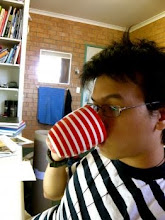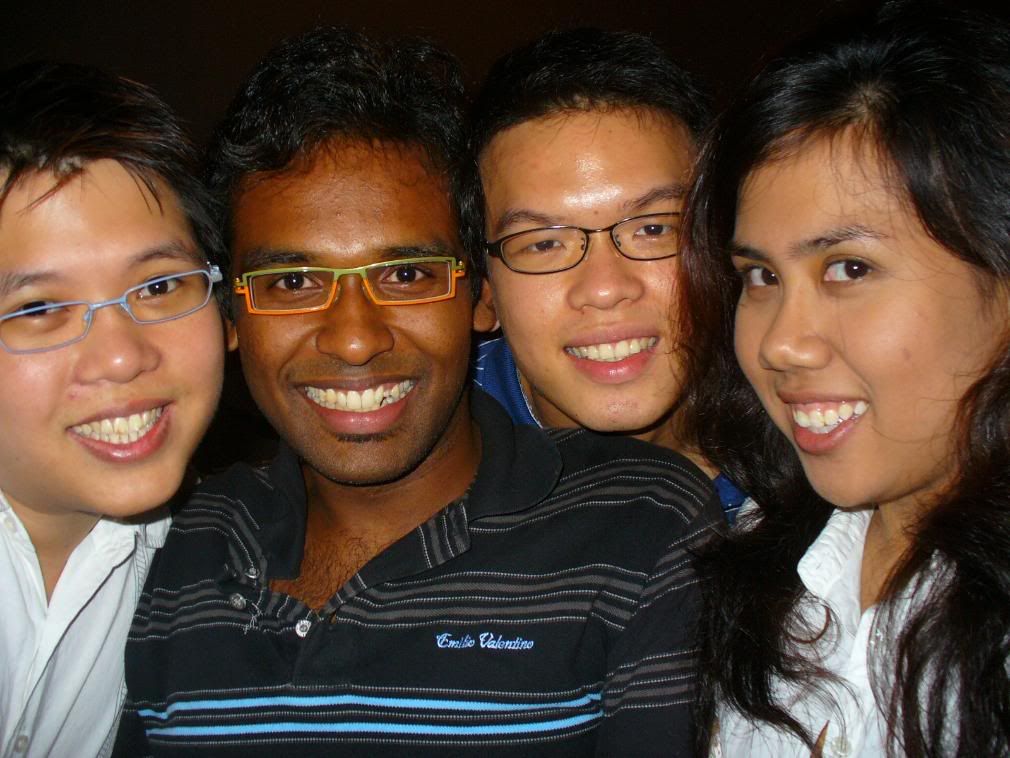Below taken from BldgBlog http://bldgblog.blogspot.com/2009/07/architecture-of-blink.html
An article posted today on New Scientist suggests that, over the course of a 150-minute film, audience members will miss an incredible fifteen minutes simply through the act of blinking – but also that people watching a film tend to blink at the same time.
It's called "synchronized blinking," and it means that "we subconsciously control the timing of blinks to make sure we don't miss anything important" – with the addendum that, "because we tend to watch films in a similar way, moviegoers often blink in unison." That is, they blink during "non-critical" moments of plot or action, creating a kind of perceptual cutting-room floor.
On the one hand, then, I'm curious if this means that clever editors, like something out of Fight Club, might be able to insert strange things into those predicted moments of cinematic calm – moments deemed safe for blinking – simply to see if anyone notices, but I'm also left wondering if there is an architectural equivalent to this: a spatial moment inside a building in which it seems safest for us to blink.
In other words, do people not blink when they first walk into a space like Rome's Pantheon or into Grand Central Station – or is that exactly when they do blink, as if visually marking for themselves a transition from exterior to interior?
It would seem, then, that if film has moments of synchronized blinking, then so might architecture – but when do we choose to blink when experiencing architectural space, and do those moments tend to occur for all of us at the same time?
How could we test this?
Further, if there is, in fact, a moment inside a building somewhere where almost literally everyone blinks– say, in the lobby of the Museum of Modern Art, or in a bathroom corridor in the history building at your own university – could we say that that space is somehow yet to be fully seen?
It is the spatial equivalent of those fifteen minutes of a film that no one realized they missed.
After all, perhaps there's a detail in your own house that you've never actually seen before – and it's because you tend to blink as you walk past it. Your own body assumes, outside conscious awareness, that this must be a safe space for blinking; it's near a window, or the colors are very dull. Perhaps that's how spiderwebs build up: you literally don't see them.
On a much larger scale, meanwhile, are there stretches of highway somewhere outside town where the scenery gets a bit boring – and so everyone starts to blink, more or less at the same time, thus visually removing from collective cultural awareness that McDonald's, or that abandoned house, tucked away over there beside the trees?
And could you locate that exact moment of blindness – could you find blinkspots throughout the urban fabric – and start to build things there? Architecture becomes a three-dimensional test landscape for the neurology of blinking.
For instance, if people driving 65 mph travel, say, five feet with every blink, then what spatial and architectural possibilities exist within that five feet?
What are the spatial possibilities of the blink?
I'm reminded of certain zoning laws in which you need to consider the exact amount of shadow your building will cast on the neighborhood around it before beginning construction.
But what about zoning for blinks? Can you zone a building for maximum blinks?
Or perhaps the opposite: a new genre of architecture, specially designed for Halloween fun houses, in which it's too stressful to close your eyes even for a micro-second...
Thursday, August 20, 2009
Monday, August 17, 2009
Yahoo Answers.
Below taken from Yahoo! Answers.
http://answers.yahoo.com/question/index?qid=20070712203757AAmGU16
Question: Why, oh why, didn't I take the blue pill?
Best answer chosen:
Great question!!!
The choice between a red/blue pill is the basic dilemma faced by atheist and believer in choosing between reality or fantasy. Should we choose the red pill of wisdom (free thinker / skeptic / atheist), or the blue pill of happiness (believer / religion / faith / not questioning)? In a nutshell, do humans want to be wise or happy? As your question notes, many willingly choose the blue pill or the philosophy of 'ignorance is bliss'.
http://en.wikipedia.org/wiki/Redpill
“The use of a red pill is an allusion to the use of a similar device in Alice's Adventures in Wonderland. The Matrix movies commonly use references from this other work of fiction. For instance, when Morpheus offers the red pill to Neo, he says that by taking the red pill, he would show Neo "how deep the rabbit hole goes." The red pill also features in the movie Total Recall. In this movie the protagonist Quaid is purported to be having a schizo-paranoia episode, resulting in the situation he finds himself in on Mars. The red pill is, here, the path 'out' of this episode and back to a normal life.”
Cypher: I know what you're thinking, 'cause right now I'm thinking the same thing. Actually, I've been thinking it ever since I got here: Why oh why didn't I take the BLUE pill?
Morpheus: The Matrix is everywhere, it is all around us. Even now, in this very room. You can see it when you look out your window, or when you turn on your television. You can feel it when you go to work, or when go to church or when you pay your taxes. It is the world that has been pulled over your eyes to blind you from the truth.
Neo: What truth?
Morpheus: That you are a slave, Neo. Like everyone else, you were born into bondage, born inside a prison that you cannot smell, taste, or touch. A prison for your mind. (long pause, sighs) Unfortunately, no one can be told what the Matrix is. You have to see it for yourself. This is your last chance. After this, there is no turning back.
(In his left hand, Morpheus shows a blue pill.)
Morpheus: You take the blue pill and the story ends. You wake in your bed and believe whatever you want to believe. (a red pill is shown in his other hand) You take the red pill and you stay in Wonderland and I show you how deep the rabbit-hole goes. (Long pause; Neo begins to reach for the red pill) Remember -- all I am offering is the truth, nothing more.
(Neo takes the red pill and swallows it with a glass of water)
The Matrix can also be a metaphor for religion. e.g. replace “Matrix” w/ “religion” in the paragraph below.
"Morpheus: The Matrix is a system, Neo. That system is our enemy. But when you're inside, you look around, what do you see? Businessmen, teachers, lawyers, carpenters. The very minds of the people we are trying to save. But until we do, these people are still a part of that system and that makes them our enemy. You have to understand, most of these people are not ready to be unplugged. And many of them are so inured, so hopelessly dependent on the system, that they will fight to protect it."
It is of course, no small coincidence that the occupation of "carpenter" was inserted by the writers.
"Religion is but a desperate attempt to find an escape from the truly dreadful situation in which we find ourselves. Here we are in this wholly fantastic universe with scarcely a clue as to whether our existence has any real significance. No wonder then that many people feel the need for some belief that gives them a sense of security, and no wonder that they become very angry with people like me who say that this is illusory."
— Fred Hoyle
"What I conclude is that religion has nothing to do with experience or reason but with deep and irrational needs."
— Richard Taylor
http://answers.yahoo.com/question/index?qid=20070712203757AAmGU16
Question: Why, oh why, didn't I take the blue pill?
Best answer chosen:
Great question!!!
http://en.wikipedia.org/wiki/Redpill
“The use of a red pill is an allusion to the use of a similar device in Alice's Adventures in Wonderland. The Matrix movies commonly use references from this other work of fiction. For instance, when Morpheus offers the red pill to Neo, he says that by taking the red pill, he would show Neo "how deep the rabbit hole goes." The red pill also features in the movie Total Recall. In this movie the protagonist Quaid is purported to be having a schizo-paranoia episode, resulting in the situation he finds himself in on Mars. The red pill is, here, the path 'out' of this episode and back to a normal life.”
Cypher: I know what you're thinking, 'cause right now I'm thinking the same thing. Actually, I've been thinking it ever since I got here: Why oh why didn't I take the BLUE pill?
Morpheus: The Matrix is everywhere, it is all around us. Even now, in this very room. You can see it when you look out your window, or when you turn on your television. You can feel it when you go to work, or when go to church or when you pay your taxes. It is the world that has been pulled over your eyes to blind you from the truth.
Neo: What truth?
Morpheus: That you are a slave, Neo. Like everyone else, you were born into bondage, born inside a prison that you cannot smell, taste, or touch. A prison for your mind. (long pause, sighs) Unfortunately, no one can be told what the Matrix is. You have to see it for yourself. This is your last chance. After this, there is no turning back.
(In his left hand, Morpheus shows a blue pill.)
Morpheus: You take the blue pill and the story ends. You wake in your bed and believe whatever you want to believe. (a red pill is shown in his other hand) You take the red pill and you stay in Wonderland and I show you how deep the rabbit-hole goes. (Long pause; Neo begins to reach for the red pill) Remember -- all I am offering is the truth, nothing more.
(Neo takes the red pill and swallows it with a glass of water)
The Matrix can also be a metaphor for religion. e.g. replace “Matrix” w/ “religion” in the paragraph below.
"Morpheus: The Matrix is a system, Neo. That system is our enemy. But when you're inside, you look around, what do you see? Businessmen, teachers, lawyers, carpenters. The very minds of the people we are trying to save. But until we do, these people are still a part of that system and that makes them our enemy. You have to understand, most of these people are not ready to be unplugged. And many of them are so inured, so hopelessly dependent on the system, that they will fight to protect it."
It is of course, no small coincidence that the occupation of "carpenter" was inserted by the writers.
"Religion is but a desperate attempt to find an escape from the truly dreadful situation in which we find ourselves. Here we are in this wholly fantastic universe with scarcely a clue as to whether our existence has any real significance. No wonder then that many people feel the need for some belief that gives them a sense of security, and no wonder that they become very angry with people like me who say that this is illusory."
— Fred Hoyle
"What I conclude is that religion has nothing to do with experience or reason but with deep and irrational needs."
— Richard Taylor
Sunday, August 16, 2009
Milk crates
Text from http://mathieugallois.com/diy_8.html
Light weight, strong, stackable and easily modified, the iconic milk crate – the starting point of so much DIY stuff! Used universally as a seat in the street, a handy container – and a thousand other users; the milk crate in Australia is the object that comes closest to transcending notions of individual or corporate ownership (in the eyes of most, but perhaps not milk distributors).
The generic milk crate 'belongs' to a fluid zone reminiscent of the White Bicycle Plan started in the 1960s by Luud Schimmelpenninck in Amsterdam, the Netherlands. This so-called White Bicycle Plan was possibly the first large-scale community bicycle program. It provided free bicycles that were supposed to be used for one trip and then left for someone else.

Below picture from http://www.freshbump.com/featured/special-features/25-innovative-re-purposed-home-fittings-designs/

Light weight, strong, stackable and easily modified, the iconic milk crate – the starting point of so much DIY stuff! Used universally as a seat in the street, a handy container – and a thousand other users; the milk crate in Australia is the object that comes closest to transcending notions of individual or corporate ownership (in the eyes of most, but perhaps not milk distributors).
The generic milk crate 'belongs' to a fluid zone reminiscent of the White Bicycle Plan started in the 1960s by Luud Schimmelpenninck in Amsterdam, the Netherlands. This so-called White Bicycle Plan was possibly the first large-scale community bicycle program. It provided free bicycles that were supposed to be used for one trip and then left for someone else.

Below picture from http://www.freshbump.com/featured/special-features/25-innovative-re-purposed-home-fittings-designs/

Tuesday, August 4, 2009
Twisted Princess
Came across this. Amazing. Here are three of my favourite. I guess Snow White could have been darker.



Go to http://jeftoon01.deviantart.com/gallery/#Twisted-Princess to see the whole range.



Go to http://jeftoon01.deviantart.com/gallery/#Twisted-Princess to see the whole range.
Subscribe to:
Posts (Atom)













